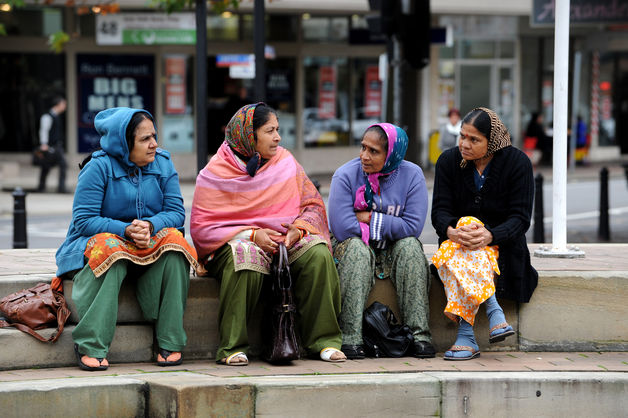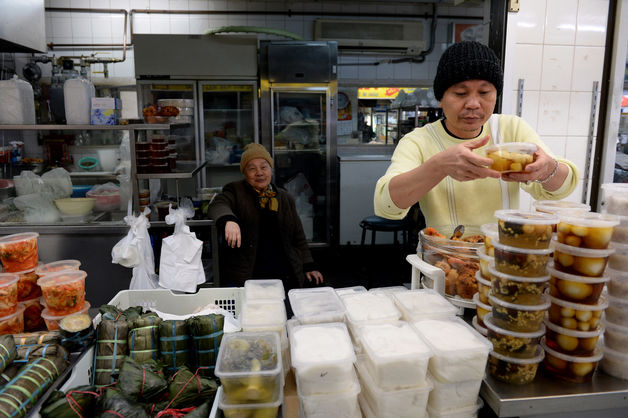
A group of women chat while sitting on some steps on Church Street mall in the suburb… Read More
A group of women chat while sitting on some steps on Church Street mall in the suburb of Parramatta in western Sydney. Australia’s 2011 census showed 43 percent of the population has at least one parent born overseas. Close
A group of women chat while sitting on some steps on Church Street mall in the suburb of Parramatta in western Sydney. Australia’s 2011 census showed 43 percent of the population has at least one parent born overseas.
Manoj Wanzare, an Indian fund manager with a master’s in business administration, personifies Australia’s best bet to address the risk of a slump in income growth as the nation’s once-in-a-century mining boom fades.
Wanzare, 37, has the type of education credentials that Australia is singling out for credit in its immigration system. The initiative offers the prospect of increased productivity and a fresh pool of domestic demand amid a slowdown that’s seen the economy expanding at three quarters of a percentage point less than its average of the past decade.
“A migrant hops onto a treadmill at a different speed,” said Wanzare, a senior portfolio manager at Plato Investment Management Ltd. in Sydney who moved to the country six years ago. “Just to be where you are you have to run a bit harder.”
A bipartisan openness toward immigration has helped ensure a surge in the share of the population born overseas to almost 28 percent, the most since the 19th century. While raising environmental challenges and the risk of racial tensions, a projected doubling of the population to 46 million by 2075 helps Australia stand out among developed nations including Japan seeing their numbers shrink.
“These are the people who can expand the new industries that we already need to complement mining, and increasingly make up for it in underpinning our economic standard of living,” said Glenn Withers, a professor of economics at the Australian National University who helped design the points system used to rate potential migrants.

Customers queue outside Apple Inc.’s George Street store in anticipation of the launch… Read More
Customers queue outside Apple Inc.’s George Street store in anticipation of the launch of the company’s new iPad in Sydney. The surge of immigrants is providing skilled workers and a source of consumer demand in a nation that has seen its 2013 growth rate lag the 10-year average by three quarters of a percentage point. Close
Customers queue outside Apple Inc.’s George Street store in anticipation of the launch of the company’s new iPad in Sydney. The surge of immigrants is providing skilled workers and a source of consumer demand in a nation that has seen its 2013 growth rate lag the 10-year average by three quarters of a percentage point.
Indians and Chinese have surpassed the British as the biggest arrivals, helping transform the nation that operated the discriminatory White Australia Policy from federation in 1901 that was only fully dismantled in 1973.
Skilled Migrants
Following a post-World War II wave of Europeans, Australia opened to Asians in the 1970s when Vietnamese refugees fled the victorious communist regime and late 1980s as Chinese students were given visas after the Tiananmen Square uprising. Skilled migrants have since made up an increasing share of arrivals.
People born overseas now make up 27.7 percent of the population, according to 2013 figures from the United Nations’ Department of Economic and Social Affairs. That compares with 14.3 percent in the U.S., 12.4 percent in the U.K., and 20.7 percent in Canada.
The Reserve Bank of Australia forecasts economic growth will remain below average next year and the Treasury projects the jobless rate will rise to an 11-year high of 6.25 percent by June. The RBA, which cut rates by 225 basis points since late 2011 to a record-low 2.5 percent, expects the economy to pick up after that, driven by low borrowing costs, expansions among major trading partners, and strong population growth.

Lam Nguyen, right, arranges containers of food as Thi Huong Le looks on at her… Read More
Lam Nguyen, right, arranges containers of food as Thi Huong Le looks on at her Vietnamese food store in the suburb of Cabramatta in western Sydney. Close
Lam Nguyen, right, arranges containers of food as Thi Huong Le looks on at her Vietnamese food store in the suburb of Cabramatta in western Sydney.
Immigration Boost
Immigration is “incredibly important,” RBA Deputy Governor Philip Lowe said Nov. 26 in Sydney. “They bring management skills, they bring technology skills, they bring a commitment to hard work.”
An elevated currency has hampered RBA efforts to rebalance the economy and drive growth in non-mining industries. The Aussie climbed almost 50 percent from 2009 through 2012 as the nation escaped the global downturn and investment to meet Chinese demand for raw materials spurred growth.
The local dollar has declined 13 percent this year as the boom began to fade. The value of mineral and energy projects being developed dropped 10 percent to about A$240 billion ($218 billion), the Bureau of Resources and Energy Economics said Nov. 27. Five projects worth a combined A$1.7 billion moved to the committed stage in the six months to October, the lowest number and value in more than a decade.
Racial Tensions
Along with stimulus, immigration has brought challenges. In 2009, attacks on Indian students in Melbourne dented the reputation of the education industry, the fourth biggest foreign-exchange earner.
Bob Carr, premier of New South Wales state from 1995 to 2005 and foreign minister from March 2012 till September, says a pro-migration business lobby has encouraged an expansive program even as it pressures the world’s most arid inhabited continent.
“Why is it in Australia’s interests to push immigration at the very highest levels?” he said in a telephone interview. “We know we’ve got problems with an erratic rainfall pattern, we know our rivers sometimes end up grudging streams, we know we’ve got a lot of land degradation and that we cling to the coast, a fertile coastal strip.”
Indian Influx
India accounted for 21 percent of immigrants in the year through June, taking over from China two years ago and leaving the U.K. in third place. The top 10 are rounded out by the Philippines, South Africa, Vietnam, South Korea, Ireland, Malaysia and Sri Lanka. Australia’s 2011 census showed 43 percent of the population had at least one parent born overseas.
Under Australia’s skilled migration program, aspiring migrants complete a survey that allocates points based on age, education and work history. If they pass, they may then be asked to apply for a visa. A maximum 30 points are awarded to people aged 25 to 32, while those aged 45 to 49 get zero; a doctoral degree from an Australian university or recognized institution gets 20 points, a bachelor’s 15 and a tertiary diploma 10.
Wanzare, who avoided the “consensus trade” of his university classmates of a U.S. move, had previously worked as a hedge fund manager in Tokyo. He now lives in an apartment overlooking Sydney’s harbor bridge and opera house and says the biggest drawback of Sydney life is the cost.
“I find it equal to Tokyo or in certain cases more expensive,” said Wanzare, who has an MBA from McGill University, Canada. “That was a bit of a surprise.”
Costly Homes
The average home price in Australia’s biggest cities rose 8 percent in November from a year earlier, the biggest annual gain since the year ended Oct. 31, 2010, to an all-time high of A$606,003, according to the RP Data-Rismark home value index. Prices in Sydney surged 14 percent in the 11 months to Nov. 30 to a record A$724,628.
Hanson Han, a 30-year-old married father of one who was born in China, moved to Sydney in 2009 to capitalize on his homeland’s increased ties with Australia and now works at a Chinese agricultural investment company.
“I’m quite bullish about the Australian market both from the medium and long-run because of the location so close to the Asian region,” he said.
Newcomers like Han and the skills they bring will be key to averting what the Treasury’s top economic forecaster David Gruen projects could be the weakest income growth in half a century in the next 10 years unless productivity picks up.
Productivity Challenge
Australia will need labor productivity to improve by an average 3.2 percent per year for a decade — something never achieved — in order to sustain current income growth rates, according to Gruen.
Since 2006, about 44 percent of working-aged migrants held a bachelor’s degree or higher qualification before coming to Australia, according to a government report, compared with 24 percent for Australians aged 15 to 64 years. A 2010 report found 89 percent of migrants are younger than 40 when they arrive, versus 55 percent for the resident population.
“We bring in people with high human capital,” said Warwick McKibbin, an economics professor at Australian National University and former central bank board member. “That’s a big boost to productivity.”
Even among developed nations, there remains demand for moving to Australia.
Stephen Price, a software developer for Credit Suisse Group AG in Sydney who arrived with his now wife in January 2008, went back to Dublin for Christmas last year. Catching up with home-town friends, he found that four of his 10 closest mates are getting their papers together to come to Australia.
“A lot of my friends back home are now unemployed and a bit down in the dumps, whereas I’m getting on pretty well down here,” said Price, 36. “Our lives have gone in different directions.”
To contact the reporters on this story: Michael Heath in Sydney at mheath1@bloomberg.net; Candice Zachariahs in Sydney at czachariahs2@bloomberg.net
To contact the editor responsible for this story: Stephanie Phang at sphang@bloomberg.net
Source Article from http://www.bloomberg.com/news/2013-12-09/immigration-offers-australia-cushion-as-mining-investment-slows.html
Immigration Influx Buoys Australia as Mining Boom Fades: Economy
http://www.bloomberg.com/news/2013-12-09/immigration-offers-australia-cushion-as-mining-investment-slows.html
http://news.search.yahoo.com/news/rss?p=immigration
immigration – Yahoo News Search Results
immigration – Yahoo News Search Results
